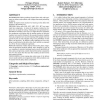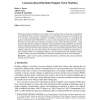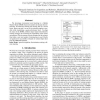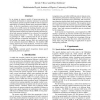127
Voted
ICASSP
2011
IEEE
14 years 4 months ago
2011
IEEE
Unsupervised acoustic model training has been successfully used to improve the performance of automatic speech recognition systems when only a small amount of manually transcribed...
123
Voted
ICASSP
2011
IEEE
14 years 4 months ago
2011
IEEE
We propose a kernelized maximal-figure-of-merit (MFoM) learning approach to efficiently training a nonlinear model using subspace distance minimization. In particular, a fixed,...
123
Voted
ICASSP
2011
IEEE
14 years 4 months ago
2011
IEEE
Shrinkage-based exponential language models, such as the recently introduced Model M, have provided significant gains over a range of tasks [1]. Training such models requires a l...
124
Voted
TNN
2010
14 years 7 months ago
2010
Abstract--An Elman network (EN) can be viewed as a feedforward (FF) neural network with an additional set of inputs from the context layer (feedback from the hidden layer). Therefo...
106
Voted
TLT
2010
14 years 7 months ago
2010
In the recent years, usage of the third-person perspective (3PP) in virtual training methods has become increasingly viable and despite the growing interest in virtual reality and ...
109
Voted
PROMISE
2010
14 years 7 months ago
2010
BACKGROUND: Defect predictors learned from static code measures can isolate code modules with a higher than usual probability of defects. AIMS: To improve those learners by focusi...
117
Voted
JMLR
2010
14 years 7 months ago
2010
This paper develops algorithms to train support vector machines when training data are distributed across different nodes, and their communication to a centralized processing unit...
115
click to vote
INTERSPEECH
2010
14 years 8 months ago
2010
We investigate incremental word learning in a Hidden Markov Model (HMM) framework suitable for human-robot interaction. In interactive learning, the tutoring time is a crucial fac...
116
click to vote
INTERSPEECH
2010
14 years 8 months ago
2010
In an attempt to improve models of human perception, the recognition of phonemes in nonsense utterances was predicted with automatic speech recognition (ASR) in order to analyze i...
152
Voted
CVPR
2011
IEEE
14 years 9 months ago
2011
IEEE
The deformable part-based model (DPM) proposed by Felzenszwalb et al. has demonstrated state-of-the-art results in object localization. The model offers a high degree of learnt in...







